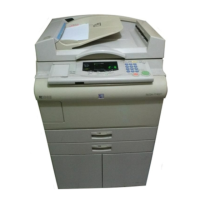12.5 DUPLEX STACKING
There are two motors for driving the fences. The side jogger fences are
driven by the side fence jogger motor [A]. The end jogger fence is driven by
the end fence jogger motor [B]. Using two separate motors for the side and
end fences allows the duplex tray to handle all paper sizes from A3/11" x 17"
to A5/ 8
1/2
" x 5
1/2
" sideways.
There are two home position sensors. One is for the jogger fences [C], and
the other is for the end fence [D]. When the main switch turns on, the side
fence jogger motor and the end fence jogger motor rotate to place the jogger
fences and the end fence at their home positions.
When the registration clutch turns on, the side fences move 10.5 mm, and
the end fence moves 8.7 mm away from the selected paper size. Then,
when the copy paper is delivered to the duplex tray, the jogger fences move
inward to square the paper. (This is done 690 ms [A156] or 920 ms [A160]
after the duplex turn sensor detects the trailing edge of copy paper. The
duplex turn sensor is [E] in the diagram on the previous page) Shortly after
this, the jogger fences move back to their previous positions. After the last
copy of the first side copy run enters the duplex tray, the jogger fences
remain against the paper stack.
There are two end fences. One [E] is for A3/11 x 17" size paper. The other
[F] is for sizes smaller than B4. They are included as a unit. When A3/11 x
17" size paper is in the duplex tray, the end fence unit moves to the left and
the B4 end fence rotates down as it is pressed against the end fence stopper
[G].
[C]
[A]
8.7 mm
10.5 mm
10.5 mm
[D]
[B]
[G]
[E]
[F]
Detailed
Descriptions
STM 2-101 A156/A160/A162

